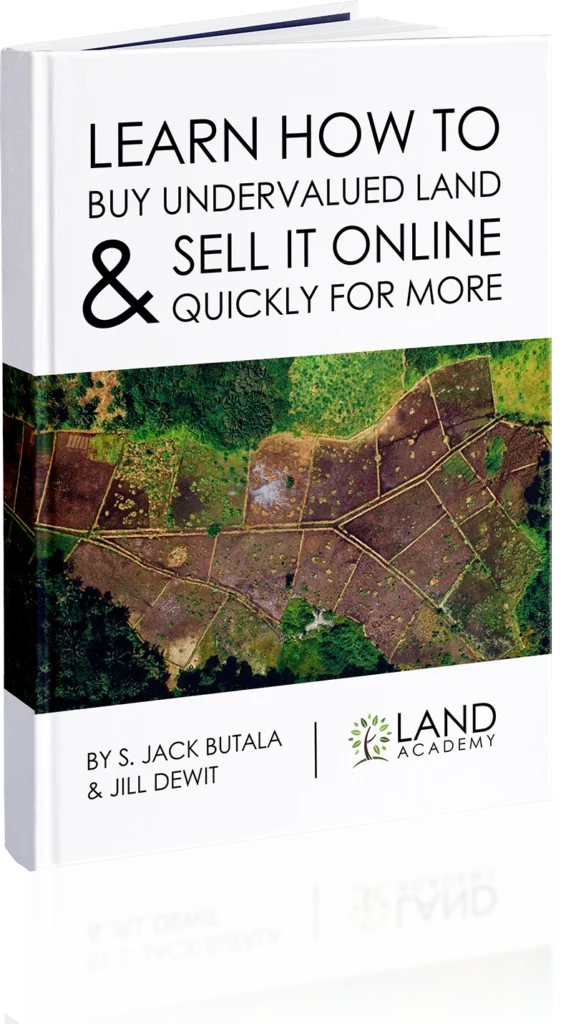This is episode number 2246. Jill and I are talking about why we don’t negotiate land and house real estate deals. People are like, “That doesn’t make any sense. What could this possibly be about? How special do you think you are?” I think I’m pretty special when it comes to this mailer. There’s a healthy level of competition for most people. If you’re a professional golfer, you need to have the most acute, crazy sense of competition there ever was to be successful at your job.
For the rest of us, the vast majority of people that I know take negotiation to a much terrible, unhealthy place where it’s not about the deal anymore. It’s about winning at the negotiation. You stop applying common sense, like, “This house costs $500,000. They won’t come off the price. I want it for $5,000 less or I’m not buying it.” That’s why this title was written. It becomes a personal, “I’m going to win,” scenario, and that’s sad. We’ll talk about that in a minute.
There’s a reason for it. Do you want to know what it is?
Yeah.
If it’s like that, then they’re trying to kill the deal. They don’t want it.
Do you mean subconsciously?
No, consciously, or maybe some consciously. For me, it’s consciously. I’m digging in like I’m either going to get exactly how I want it or I’m not going to get it. I’m fine with that because I don’t want it that bad.
Negotiation Lessons From “Never Split the Difference”
We’re going to talk about that in detail. I like this topic. Each day on the show, we answer a question from our Land Academy Member Discord Forum and take a deep dive into land-related topics by your request. I asked AI to summarize Never Split the Difference, the book that we all know about by Chris Voss, which is considered one of the bibles of negotiation.
Here’s what AI said. There are 5 or 6 points that it spit back out. I’m going to read them each. Jill negotiates all our deals very successfully, so I want her opinions. AI says that the book is all about active listening, empathy, and understanding the other party’s perspective, emotions, and underlying needs. Thoughts, Jill?
I agree. I do it without thinking about it.
Number 1 of 5, tactical empathy. Demonstrating what you understand, even if you don’t agree. Can you give us an example of tactical empathy?
I can’t imagine what that would feel like. Can you tell me more about that?
Number two, labeling emotions. Acknowledging the other person’s feelings to de-escalate the tension.
“That must’ve been hard to hear. I’m sorry. It’s always hard to hear that. I would imagine it’d be hard to hear, too, that my property’s worth half what it is.”
That’s excellent. I blindsided Jill completely.
This is adlib.
She had no idea what this was about. Number three, accusations audits. Proactively addressing negative perceptions the other party might have.
I got one.
Go ahead.
“You’re right. You don’t know me. How do you know me from anybody else? Let me tell you about me and my business. Please feel free to look me up.”
Calibrated questions. Open-minded questions designed to make the other party feel like they’re coming up with a solution themselves.
Open-ended questions are great. I love this because I often ask open-ended questions like, “Why are you selling?” I’m going to get something out of it. I’m going to figure out what their why is or their emotion. I’m like, “Why are you selling? They’re like, “I lost my job. I’ve tried and tried. I can’t find anything here, so I’m going to pack it up and go back home to whatever state.”
No-oriented questions. Framing questions with the illicit no answers, which can make people feel more in control and lead to a yes later.
That’s easy. It’s turning things around so you’re on the same page with them. It’s like, “If you called me, I’d probably say the same thing about my fill-in-the-blank primary residence. We’re all saying no. There’s a number that doesn’t make sense. You’re right.” We’re getting a little bit on the same team there, and then we’re going to get on the same page. It’s like, “There’s a number that does make sense. You’re right.”
I would call all of this establishing trust.
Part of it.
Here’s the last one. Bargaining for how. Shifting from yes or no to finding out how something can be achieved.
I do that all the time. I’m like, “I want to buy it. You want to sell it. Do we agree on that? We do. We’ve got to find the middle ground. I’m going to get it done quickly and conveniently. I’m going to do all the work. I’m going to pay the closing costs. What is that number that makes sense to you, knowing all that? You don’t have to get an agent. You’re not paying commission. You’re not waiting six months hoping, dealing with a photographer, or whatever that is. I’m taking all that stuff off your plate to get it done now, and that’s worth something.” They’re like, “You’re right.”
All of this does not address price. This is where everybody gets hung up with negotiation. I sent out an offer for $22,000. The seller comes back after a little bit of back and forth and says, “I’ll sell you the property for $40,000. It might be worth more, or it might not. I don’t know, but $40,000 is my bottom number.”
That’s the seller talking.
My offer in the mail was $22,000. Where people get hung up is focusing on is talking about the price. I’ve heard you do this perfectly, by walking by your office. What Jill does is she starts to find out what’s going on.
I ask, “Why do you think it’s worth that?”
“What is going on in your world that you can’t come off at that price?” It’s like she said. “I know you want to sell it. I want to buy it. How do we get together on this thing? Tell me about what’s going on here, and maybe we can work something out in some other way.”
When you come back to this $40,000 thing, an open-ended question will often smoke it out. They say, “That’s what my mortgage is on my house over here, and I’ve got to get out of it.” I’m like, “I know what’s going on. Let’s see what we can do here.”
Maybe then the answer is everybody agrees it’s no. The dude needs $40,000. I’m at $22,000.
I can’t do it.
A hard no at the end. Do you know why? It’s as good as a yes.
You could even help them. I could say, “I could come up to $30,000. Can you sell a car? What do you have? Do you have any 401(k) money to get you out of this GM? That might do it. We’re all going to agree that you’re not going to get $40,000 anyway, no matter what you do. It’s not possible, or at least not this fast.” They’re like, “You’re right.” I say, “You need to get out of this jam fast. I’ll help you go. You sell the car. I’ll buy the property. We’re going to get you $40,000 at the end of the month.” They’re like, “You’re right. That would work. That could do it.”
A lot of years ago, I had Jill’s job and wasn’t anywhere as near as good as she is at it, but I’ll tell you what worked for me most of the time. It’s like, “I understand that you need $40,000 to pay off your mortgage, but I’m standing here with $22,000. That’s more than half. I’m not banking any bones about it. It’s what the property is worth to me. We can close on Thursday. I don’t want your answer now. Please talk to your wife about it or whatever, but it gets you more than halfway there. On Thursday, you can have the dough.”
I stay with the numbers. Jill doesn’t, and the guy who wrote this book clearly doesn’t. It works, but there is a backdoor way of trying to get somebody to say some words that they don’t necessarily want to say. Plus, it’s the 21st century. People can figure this crap out. It’s not like you got to go find a Dale Carnegie book somewhere to figure it out. It’s all over the internet about what’s happening. You have to choose your style and stick with it. I also think my lack of interest in negotiating price is the reason that I came up with this mailing scenario in the early ‘90s.
Why We Don’t Negotiate Land And House Deals
We’re on the topic. The question is a topic. Let’s meld it together.
It’s about why we don’t negotiate land and house deals.
You said something that I always come off my number. I don’t.
I didn’t mean that.
You said that, and I thought, “I could think of a certain acquisition that I stood firm on my number.”
I wasn’t saying you do that. I meant the seller.
That’s not my goal, but I know what you’re saying. For some people, that’s their goal. Their goal is to send out any offer, no matter what it is, to elicit a call back to then negotiate a deal.
I agree.
That’s not what we do.
That’s not what this is for.
That’s so much harder and so much more work. That’s the same thing as sending a neutral letter saying, “I want to buy your house. I want to buy your property. Call me.” Everybody’s going to call you because they all think you’re the one. They’re going to be like, “We finally got the one person who sees the beauty of this. They’re going to give us $1 million because they’re in love with that hill.” That’s not what’s going on.
You could send a range. The range is my favorite. Your range is $2,000 to $20,000. You mean $2,000 and they see $20,000. Whatever it is, they always see the top number. I argue, why bother sending a range? Pick a number and then work from that. When you get into these, there are the ready-to-go people. We talk about this often. They don’t care about the money. You are the person who it landed in their mailbox when they were like, “If someone would give me more than $5 for this, I would give it to them.” We’ve all had those conversations about something in your world.
We’ve all been those people, too.
That’s what I’m saying. Here comes your letter, and they’re like, “Done. This guy is giving this to me for $1,500. Do I say anything? No. Hurry up and get it done. He’s happy. You’re happy. Move forward.” That’s what happens.
What Jill said is the reason we send mail out the way that we do. A certain predictable percentage of people who receive that letter at that time are going to say, “I’m done.”
There are more people who are like, “I didn’t like your $1,500. Give me $2,000,” because they need to get something, or $2,000 means something to them. $2,000 is going to get them out of whatever jam they have this week, or $2,000 is the number they had in their head that they had always thought, “At least I’m going to make that much money off of it.” It didn’t happen the way I wanted it to, but that’s fine.” You’re okay with $2,000 because it’s worth $20,000 or $15,000.
I would call that a reasonable price adjustment. I would not call that negotiating.
That’s it. It comes to the big numbers. I still don’t negotiate, but I do this. They have a big number and a little number. I’m not going to give them a big number because then I’m buying retail. That’s not my business model. I would be out of business if I paid retail for everything. That doesn’t work. There’s a percentage in the middle that it’s not negotiating, but it might be a price adjustment.
I have had things come back like, “You don’t know this area, do you?” I’m like, “I thought I did. What am I missing?” That’s another thing, too. I don’t come at them hard. I let them think they’re winning and they’re in control here. I go, “What am I missing?” They’re like, “This is the only area that you can fill-in-the-blank.” I’m like, “I didn’t know that.” I go back and do my research, and they might be right. It might be something worth making adjustments. I’m still not going to pay retail, but my $2,000 offer or $20,000 because it’s worth $50,000 or $60,000. I’m like, “$2,000 was nuts. Now I know that. It’s still going to work out.”
Next Episode: Jill’s Updated Land Buying Script For 2025
Join us in the next episode where Jill and I discuss Jill’s updated land buying script for 2025. Here’s a hint. It starts with, “Why are you selling?” You are not alone in your real estate ambition. We’re Jack and Jill, information and inspiration to buy undervalued property.















